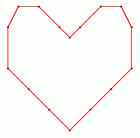Curve Reconstruction
The function discussed here is a direct application of Voronoi diagrams.
What is a Curve Reconstruction?We want to reconstruct a curve from a set of sample points . Let
The algorithm CRUST described below takes a list
S of points and returns a graph
|
Result of CRUST for a set of (non-random) points. The picture is a screenshot from the program below. |
The Algorithm
The algorithm proceeds in three steps:- Construct the Voronoi diagram
VDof the points inS. - Construct a set
L=SUV, whereVconsists of all proper vertices ofVD. - Construct the Delaunay triangulation
DTofLand makeGthe graph of all edges inDTthat connect points inL.
The Implementation
void CRUST(const list<POINT> S,GRAPH<POINT,int> G)
{
list<POINT> L=S;
map<POINT,bool> voronoi_vertex(false);
GRAPH<CIRCLE,POINT> VD;
VORONOI(L,VD);
node v; forall_nodes(v,VD) {
//add Voronoi vertices and mark them
if (VD.outdeg(v)<2) continue;
POINT p=VD[v].center();
voronoi_vertex[p]=true;
L.append(p);
}
DELAUNAY_TRIANG(L,G);
forall_nodes(v,G) if (voronoi_vertex[G[v]]) G.del_node(v);
}
Example Program for Curve Reconstruction
The following program uses CRUST to reconstruct the curve corrsponding
to the points in L and uses a window
to display the result.
#include <LEDA/core/list.h>
#include <LEDA/geo/point.h>
#include <LEDA/graphics/window.h>
#include <LEDA/geo/geo_alg.h>
using namespace leda;
int main()
{
list<point> L;
L.append(point(0,-30)); L.append(point(0,15));
L.append(point(10,-20)); L.append(point(5,20));
L.append(point(20,-10)); L.append(point(15,30));
L.append(point(25,30));
L.append(point(30,0)); L.append(point(30,20));
L.append(point(-10,-20)); L.append(point(-5,20));
L.append(point(-20,-10)); L.append(point(-15,30));
L.append(point(-25,30));
L.append(point(-30,0)); L.append(point(-30,20));
GRAPH<point,int> G;
CRUST(L,G);
window W;
W.init(-50,50,-50);
W.open(); W.display();
W.set_node_width(2);
W.set_line_width(2);
point p;
forall(p,L) W.draw_filled_node(p.to_point());
edge e;
forall_edges(e,G) {
point p=G[G.source(e)];
point q=G[G.target(e)];
W.draw_segment(p,q,red);
}
W.read_mouse();
W.screenshot("crust");
return 0;
}
See also:
Writing Kernel Independent Code
